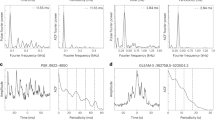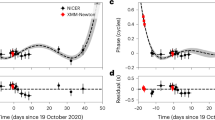Abstract
TYPE Pi 1–2 magnetic field pulsations, T = 1–150 s, have a broad-band, noise-like character and a tendency to occur during active aurorae and magnetospheric substorms1,2. It is well-known that type Pi 1–2 magnetic field pulsations observed in the night–morning sector during magnetospheric substorms maximise in amplitudes along the auroral oval1,2. But the relation of the Pi 1–2 activity to the day sector of the auroral oval has not been clear. This relation is of particular interest because the day sector of the auroral oval seems to coincide approximately with the feet of the dayside cleft field lines; the precise relation between the dayside cleft and the dayside auroral oval, however, has not yet been established (S. I. Akasofu, personal communication). Dayside cleft field lines usually terminate between the geomagnetic latitudes of 75° and 80°. We show here that intense Pi 1–2 activity appeared at College on two occasions when the cleft came down to the College latitude, 64.7° N, at times when College was in the midday sector. Further, it is shown that an intense flux of particle precipitation into the dayside ionosphere occurred on the second occasion, 4 August 1972.
This is a preview of subscription content, access via your institution
Access options
Subscribe to this journal
Receive 51 print issues and online access
$199.00 per year
only $3.90 per issue
Buy this article
- Purchase on Springer Link
- Instant access to full article PDF
Prices may be subject to local taxes which are calculated during checkout
Similar content being viewed by others
References
Akasofu, S. -I. Polar and Magnetospheric Substorms (Reidel, Dordrecht-Holland' 1968).
Saito, T. Space Sci. Rev. 22, 319–412 (1969).
Yasuhara, F. & Akasofu, S. -I. J. geophys. Res. 78, 7286–7291 (1973).
Heacock, R. R. & Hessler, V. P. High Latitude Geophysical Data, Reports UAG-C 43 to UAG-C 47 (Geophysical Institute of the University of Alaska, 1966–1967).
Hessler, V. P. High Latitude Geophysical Data, Reports UAG-C 43 to UAG-C 47 (Geophysical Institute of the University of Alaska, 1966–1967).
Hoffman, R. A. et al. J. geophys. Res. 80, 4287–4296 (1975).
Wedde, T., Doupnik, J. R., Banks, P. M., Park, R. J. & Siren, J. C. Radio Sci. 12, 285 (1977).
Leadabrand, R. L., Baron, M. J., Petricks, J. & Bates, H. F. Radio Sci. 7, 747 (1972).
Watkins, B. J., Bates, H. F., Belon, A. E. & Hunsucker, R. D. World Data Center-A Report UAG-28, Part II 492 (1973).
Hunsucker, R. D. Radio Sci. 9, 335 (1974).
Hunsucker, R. D. World Data Center-A Report UAG-28, Part II 490 (1973).
Doupnik, J. R., Brekke, A. & Banks, P. M. J. geophys. Res. 82, 499 (1977).
Kan, J. R. & Heacock, R. R. J. geophys. Res. 81, 2371–2376 (1976).
Author information
Authors and Affiliations
Rights and permissions
About this article
Cite this article
HEACOCK, R., HUNSUCKER, R. Pi 1–2 magnetic field pulsations on dayside cleft field lines. Nature 269, 313–314 (1977). https://doi.org/10.1038/269313a0
Received:
Accepted:
Published:
Issue Date:
DOI: https://doi.org/10.1038/269313a0
Comments
By submitting a comment you agree to abide by our Terms and Community Guidelines. If you find something abusive or that does not comply with our terms or guidelines please flag it as inappropriate.



